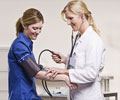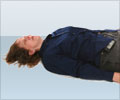A recent article described details of two types of hypotension, postprandial and postural. A brief summary is presented below.

Hypotension that appears within 2 hours following a meal and results in a fall in systolic blood pressure of more than 20 mm of Hg is called postprandial hypotension. It may occur due to multiple reasons like increase in blood flow to the intestines following a meal. It is more common in elderly individuals, those with Parkinsonism or those with a problem in the autonomic nervous system (the autonomic nervous system controls the heart and other involuntary functions). It is usually seen following breakfast or lunch, especially when meals with high glucose content are consumed. Fewer and larger meals, as well as warmer foods may also result in postprandial hypotension.
Postprandial hypotension may be prevented by adequate hydration and advising the patients to lie down following meals. Caffeine, when taken before a meal, may prevent postprandial hypotension. Octreotide has been effective in patients with autonomic dysfunction. Acarbose, an antidiabetes drug, may also be useful in this condition. Other drugs like midodrine, dihydroergotamine, indomethacin, diphenhydramine, cimetidine, fludrocortisone, and vasopressin have also been tried out.
Some people develop low blood pressure immediately on standing up; this condition is referred to as orthostatic or postural hypotension. More precisely, orthostatic hypotension refers to a reduction of systolic blood pressure of at least 20 mmHg or diastolic blood pressure of at least 10 mmHg within 3 minutes of standing. Common causes of orthostatic hypotension are reduced blood volume, intake of certain drugs, or a problem with the autonomic nervous system.
A patient with orthostatic hypotension is advised to increase salt and water intake. Some other measures could also be useful to increase the blood pressure like toe raising, crossing legs and contracting thigh muscles, elevating the legs and slow marching at one spot. These maneuvers increase the contraction of lower limb muscles and push the blood towards the upper part of the body. Bending at the waist also helps to divert the blood towards the brain. Medications that the person takes may have to be reviewed to check the cause of hypotension.
Drugs used to treat orthostatic hypotension include fludrocortisone, midodrine and pyridostigmine. Erythropoietin may be given to increase the red blood cell count and improve associated anemia. Other drugs being investigated for the purpose are droxidopa, yohimbine, dihydroergotamine, cyclooxygenase inhibitors, domperidone, and metoclopramide.
Reference
Source-Medindia









